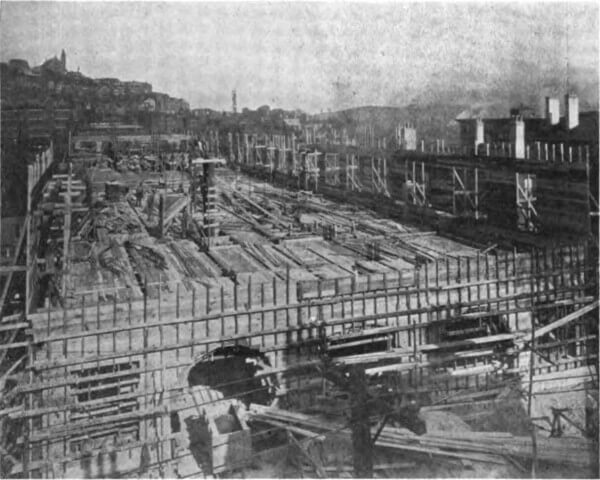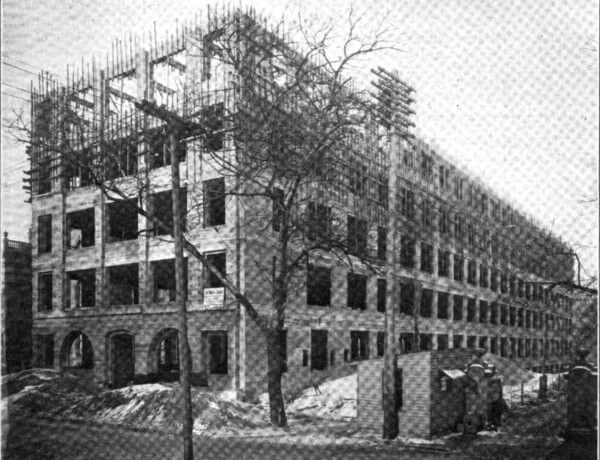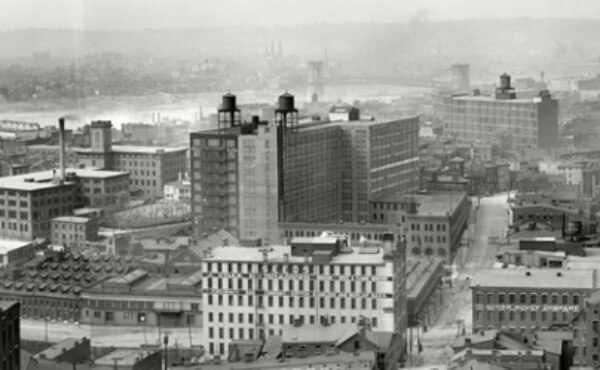Building History
400 Pike Street Through the Years
By David Holliday
(Rev B)
The original name of the Park Place at Lytle building was the Pugh Power Building. The building was named after Achilles Pugh (1805 – 1876) who founded the A.H. Pugh Printing Company in 18301. Plans were announced in early 1904 that the A. H. Pugh Printing Company would be building a concrete factory building on the east side of Pike Street between Third and Fifth at a cost of $180,0002. In addition to being the new home for the A. H. Pugh Printing Company (located at 310 Walnut Street at the time), the building would also include additional space for lease3.
Similar to the Power Building on East Eighth Street, the Pugh Power building was one of several large self-contained power buildings built to attract tenants with light manufacturing operations who preferred not to be solely dependent on the Cincinnati Gas and Electric Company for power4.
The plan for the building consisted of 7 floors facing Pike Street, and 9 floors at the rear of the building on Butler Street. This design was one floor shorter and significantly narrower than the current building being only 68’ wide (the current building is 166’ wide on Pike Street). The width of the building extended from the current south wall next to the Taft Museum, with the original north exterior wall being what is that now the south wall of the atrium5.

View of Third Floor from West to East 7

View from Northwest 8

View from Butler Street 8

View from Southwest 9
In 1904, as part of a single deal, three of the leading textile manufacturing firms of “ladies’ cloaks and garments” signed leases for four floors of space in the building. At the time, it was the single largest rental deal in the history of Cincinnati. This deal alone was said to establish the Pugh Power Building the headquarters for clothing manufacturing in the city10.
At that time, it was reported that Achilles Henry Pugh, head of the A. H. Pugh Printing Company and son of the company’s founder, had enough applications from other textile companies to fill the remaining floors several times over.
The building opened in the summer of 1905 while construction was still underway12. Construction for the original building was completed later that same year13.

The Pugh Power Building (center left) prior to expansion (circa 1906-1907)
In June of 1906, before the initial building was complete, an addition to the building was announced that would be a duplicate of the current building but one story higher with an additional floor being added to the initial building13. The estimated cost for the expansion was $300,00014. The expansion was completed in 190915. This addition now contains the area by the portions of the building north of the south wall of the atrium (generally the area occupied by the unit 1 – 2, and 14 – 21 stacks in the current building. At completion of the addition, the Pugh Power Building was considered the largest reenforced concrete building in the world16.

Rear view of The Pugh Power Building after completion of the expansion.
The original portion of the building is the darker section under the water tower on the left.
In 1976, the A. H Pugh Printing Company sold the building to Mildred G. Bauer17. In 1980 Mildred G. Bauer sold the building to the R. L. Polk & Company, a tenant of the building since 1943 for the sum of $1.5 million. The A. H. Pugh Printing Company continued their operations in the building through both sales18. Following the sale to R. L. Polk & Company, the building was renamed the R. L. Polk Building.
By the 2000s, the building was mostly left vacant. In 2004, The Miller – Valentine Group purchased the building to develop it into a mixed-use commercial/residential building. From 2004 – 2006 The Miller-Valentine Group and Greiwe Development Group converted the building into 114 residential condominiums, with the building being renamed to Park Place at Lytle in May of 200419,20.
Citations
[1] Sue Ann Painter, Architecture in Cincinnati, (Athens: Ohio University Press, 2006) 160-161.
[2] The Western Architect and Builder, April 21, 1904, 6.
[3] The Western Architect and Builder, November 24, 1904, 6.
[4] Sue Ann Painter, Architecture in Cincinnati, (Athens: Ohio University Press, 2006) 160-161
[5] Architectural drawings for the Pugh Power Building, Architects Dittoe & Wisenall.
[6] The Engineering Record, January – June 1905, 438-439.
[7] The Engineering Record, January – June 1905, 438-439.
[8] Engineering World, August 1905, 1-3.
[9] The Engineering Record, January – June 1905, 438-439.
[10] The Western Architect and Builder, November 24, 1904. 6.
[11] Engineering World, August 1905, 1-3.
[12] Engineering World, August 1905, 1-3.
[13] The Western Architect and Builder, June 14, 1906. 283.
[14] The Western Architect and Builder, August 23, 1906. 401.
[15] Engineering World, August 1905, 1.
[16] Sue Ann Painter, Architecture in Cincinnati, pp. 160 (Ohio University Press, 2006) 160-161.
[17] The Cincinnati Enquirer, June 3, 1976, 60.
[18] The Cincinnati Enquirer, February 22, 1980, 18.
[19] “Park Place at Lytle Transforming a Vacant Building to Thriving Mixed-Use T Project”, The Port of Greater Cincinnati Development Authority, https://www.cincinnatiport.org/projects/park-place-at-lytle/
[20] “Downtown’s R. L. Polk building gets new name”, Cincinnati Business Courier, May 17, 2004, https://www.bizjournals.com/cincinnati/stories/2004/05/17/daily10.html
